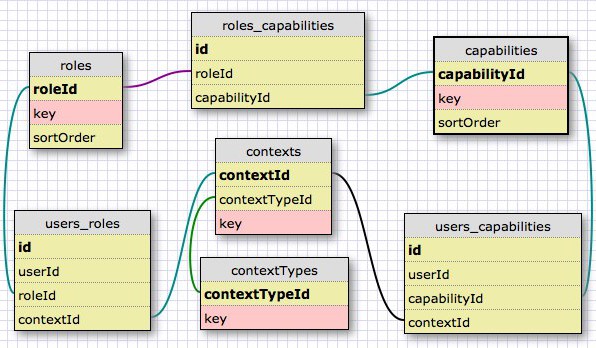Elgg’s access control system, which determines what content a user can view, is somewhat limited and very opinionated, with several use cases—access control lists, friends—baked into the core system. In hopes of making this cleaner and more powerful, I’ve been studying Drupal’s access system. (Caveat: My knowledge in this area of Drupal comes mainly from reading code, schema, docs, and two great overviews by Mike Potter and Larry Garfield, so please chime in if I run off the rails.)
Drupal
Drupal’s system also influences update and delete permissions, but here I’m only interested in the “view” permission. Also, although Drupal has hook_node_access()—a procedural calculation of permissions for a node (like an Elgg entity) already in memory—I’m focusing on the systems that craft SQL conditions to fetch only nodes visible to the user. This is critical to get right in the SQL, because if your access control relies on code, you can never predict the number of queries required to generate a list for browsing. In this area, Drupal’s realms/grants API (hook_node_grants()) is extremely powerful.
Realms and Grants in a Nutshell
At a particular time, a user exists in zero or more “realms”; more or less arbitrary labels which may be based on user attributes, roles, associations, the current system state, time…anything. Each realm has been granted (via DB rows) the permission to view individual nodes. So to query, we build up a user’s list of realms, this is baked into the query, and the DB returns nodes matching at least one realm.
E.g., at 2:30 PM today, an anonymous visitor might be in the realms (public, time_afternoon, season_winter*), whereas Mary, who logged in, might exist in the realms (public, logged_in, user_123, friendedby_345, role_developer, team_A, is_over_30, time_afternoon, season_winter). So Mary will likely see more nodes because her queries provide more opportunity to match grant rows. *Note these realms are made up examples.
Clearly this is very expressive, but Drupal (maybe for better) doesn’t provide many features out-of-the-box, so (maybe for worse) doesn’t build in many realms; the API is mostly a framework for implementing an access control system on top of added features. Contrib modules appear up to the task of providing realms based on all kinds of things (groups, taxonomies, associations with particular nodes), but it’s hard to collaboratively build an access control system, so these modules apparently don’t work well with each other and non-access modules must be careful to tap into the appropriate systems to keep nodes protected.
(Implementation oddities: The grants are done in the node_access table, which probably should’ve been called “node_grants”, especially because this table is only somewhat related to the hook called “node_access“. Less seriously—depending on your system size—each realm name (VARCHAR) is duplicated for every node/realm combination, so there’s some opportunity for normalization.)
Elgg
If you squint, Elgg’s system is a bit similar. Each entity has an “access level” (a realm), with values like “public”, “logged in”, “private”, “friends”, or values representing access control lists (a group or a subset of your friends like a Google+ circle).
That an entity can have only one realm is of course the biggest (and most painful) difference, but also the implementation is significantly complicated by some realms needing to map to different tables. E.g. Elgg has to ensure “friends” maps to rows in an entities relationship table based upon the owner of the entity, while also mapping to the ACL table.
I imagine a lot of these differences come from Drupal being old as time with a lot bigger API reboots, and because Elgg’s access system was targeted to meet the needs of features like friends and user groups, which were built-in from the beginning. It’s hard to predict which schema results in faster queries, and will depend on the use case, but Drupal queries I would guess are easier to generate and safer to alter.
Conclusions
I think in the long run Elgg would be wise to adopt a realms/grants schema, though I would probably suggest normalizing with a separate “realms” table to hold the name and other useful bits. Elgg group ACLs and friend collections would map directly into realms, but friend relationships would need to be duplicated into realms just like groups have an ACL distinct from the membership relationship. Really I think a grants table could completely replace Elgg’s “entity_relationships” table, since both tables just map one entity to others with a name.
As for Drupal, I think the docs could more clearly describe realms and grants (unless I’ve totally got this wrong). I’m less sure of the quality of the API that populates/maintains the tables; it looks like the hooks are pretty low-level ways of asking “would you like to dump some rows into node_access?” and it’s not clear how much of the table must be rebuilt or how often this happens.
 This is loosely based on
This is loosely based on